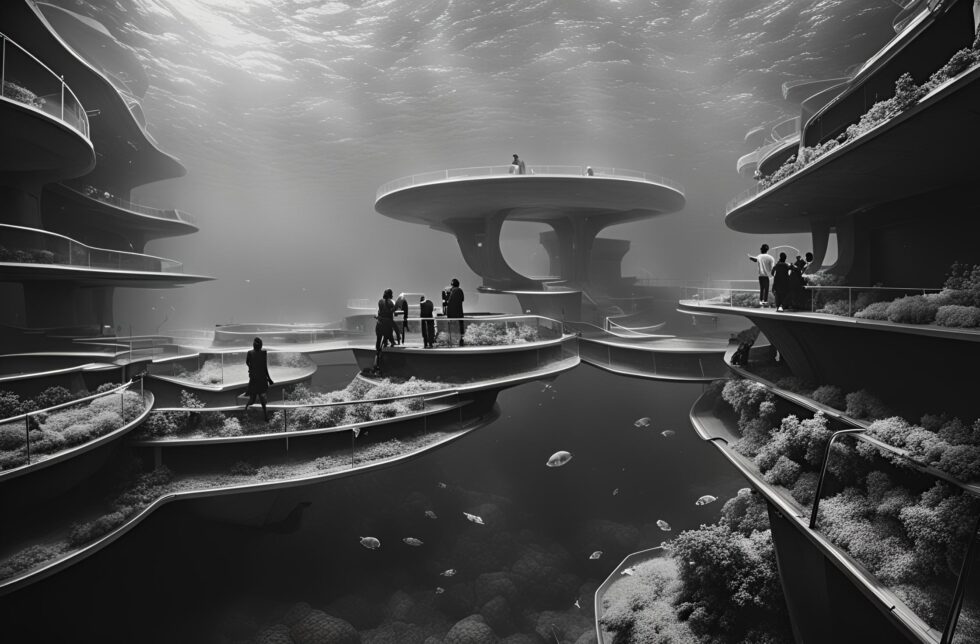
In a world where humans lived underwater, the surface of the Earth remained an untouched and mysterious expanse, while the depths of the oceans thrived with bustling cities and vibrant cultures. This transformation began millennia ago when a cataclysmic event forced humanity to adapt to an aquatic existence. Over generations, humans evolved, developing gills and webbed limbs, their bodies streamlined for swimming. The oceans, once feared and unexplored, became the cradle of civilization.

The underwater cities were marvels of engineering and design, constructed from bioluminescent corals and reinforced with the strongest materials harvested from the ocean floor. These cities glowed with a soft, ethereal light, casting a serene ambiance across the vast underwater landscapes. The largest of these cities, Atlantica, was a hub of innovation and culture. Its towering spires reached up towards the surface, a testament to human ingenuity.
Life underwater was a harmonious blend of technology and nature. Humans had learned to communicate with marine life, forming symbiotic relationships with various species. Dolphins served as messengers, their intelligence and speed were invaluable for long-distance communication. Giant sea turtles were used for transportation, their gentle nature making them ideal companions for travel. Schools of fish, guided by subtle signals, helped in farming seaweed and other underwater crops, ensuring a steady food supply.
Education and knowledge were highly valued in this society. The Great Library of Atlantica, a vast network of interconnected caverns filled with holographic records and ancient scrolls, was a beacon of learning. Scholars from all over the oceanic world gathered here to study and share their discoveries. The pursuit of knowledge extended to the exploration of the deepest trenches and the darkest corners of the ocean, where biologists and explorers uncovered new species and ancient secrets.
Despite the utopian appearance, life underwater was not without its challenges. The ocean was a dynamic and sometimes dangerous environment. Predatory creatures roamed the depths, and natural disasters like underwater earthquakes and volcanic eruptions posed constant threats. To protect their cities, humans developed advanced warning systems and defensive technologies. Walls of energy fields, powered by the geothermal heat of underwater vents, shielded the cities from harm.
One of the most significant challenges was the mystery of the surface world. Legends and myths spoke of a time when humans lived on land, but the details were shrouded in the mists of history. Curiosity about the surface grew, leading to the formation of the Surface Exploration Guild. This group of brave adventurers and scientists dedicated themselves to uncovering the secrets of the world above the waves.

The Guild’s expeditions were fraught with peril. The transition from water to air was a daunting task, requiring specialized suits and equipment. The first successful mission to breach the surface was a historic event, broadcast live to the entire underwater world. The explorers emerged into a world of dazzling sunlight and vast, open skies, a stark contrast to the familiar blue depths. They discovered remnants of ancient human civilization, now overgrown with vegetation and teeming with land-dwelling creatures.
The surface expeditions revealed that the world above was not as desolate as once believed. There were signs of life, both animal and plant, that had adapted to the new environment. The explorers brought back samples and data, sparking a wave of excitement and debate among the underwater populace. Some saw the surface as a new frontier, ripe for exploration and settlement, while others feared the unknown dangers it might hold.
As the underwater society grappled with these discoveries, a new era of exploration and innovation began. The Surface Exploration Guild expanded its missions, establishing outposts and research stations on land. They developed new technologies to bridge the gap between the two worlds, creating hybrid habitats that could support both aquatic and terrestrial life.
The reunification of the surface and underwater worlds brought about profound changes. Trade and communication between the two realms flourished, leading to a cultural renaissance. Art, music, and literature blossomed, drawing inspiration from the diverse environments. The once-separate histories of land and sea began to intertwine, creating a richer, more complex narrative of human existence.
In time, the descendants of the underwater dwellers and the surface explorers forged a new, unified society. They learned to appreciate the unique qualities of both realms, celebrating the beauty and diversity of their planet. The human race, now more adaptable and resilient than ever, thrived in their dual existence, forever shaped by their journey from the depths of the ocean to the heights of the sky.




